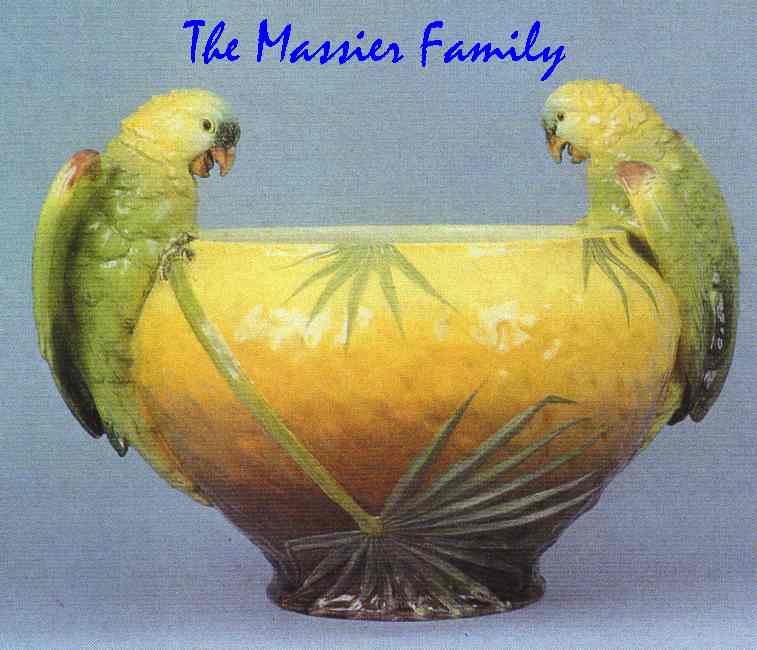

The Massiers’ work represents a link between traditional Victorian majolica and Art Nouveau pottery. There were three Massiers working in the second half of the nineteenth century, heirs to an old line of potters, who transformed traditional utilitarian ceramics into an art form. Their ancestors had worked for several centuries in Vallauris on the French Riviera, where, in the twentieth century, Pablo Picasso was reigning ceramic artist. Delphin Massier (1836 - 1907), and Clément (1845 -1917) were brothers. A cousin, Jérome (1850 – 1916) worked with them, using the signature « Jérome Massier fils ». By 1899 the family firm was divided into branches headed by these three men.
In 1860 the Massiers began to produce their vibrantly colored majolica, perhaps inspired by the flowers of the Cote d’Azur. Clément was particularly interested in designs drawn from ancient Egypt, Greece, and Rome, as well as from Renaissance maiolica. Themes from these earlier cultures appeared in his highly decorative, large pieces, including vases, ewers, and free-standing decorative columns entwined with flowers. Delphin specialized in freestanding figures of birds, animals, and shellfish – including swans, chickens, sparrows, goats, donkeys, frogs, and crabs – ranging from six to thirty-six inches high. Especially popular were his large roosters, representing the symbol of France. Cockerels and hens, thirty-six inches tall, similar to those of Minton, were extemely well modeled. As with Minton majolica, tree trunks and branches were important in Massier designs. The firm also made majolica candlesticks, vases and cachepots. An unusual pair of majolica tambourines, made by Delphin Massier about 1870, depicts an Arab and his veiled wife.
From 1860 to 1900 skilled painters and sculptors who worked with the Massiers included Jean Barerol, Jean Bagnis, Camos, the Scotsman Alexander Munrose, the Swiss sculptor James Reibert, and greatest of all, Lucien Lévy. The latter was a passionate admirer of sinuous and sensuous floral arabesque patterns and his influence was felt in the Massiers’ designs. Lévy worked with Clément Massier from 1887 to 1895 before devoting himself exclusively to painting. In Paris, under the name of Lévy-Dhurmer, he became one of the leaders of Art Nouveau.
The Massiers used in a particularly dramatic way the copper oxide flambé technique for glazing, a method that originated in China during the Sung dynasty (960 – 1280), in which the kiln is rich in carbon dioxide and low in oxygen (reduction atmosphere). The flambé technique as practiced by the Massiers also incorporated the lustre technique of the Hispano-Moresque ceramics. It entailed covering a previously glazed piece with a metallic silver or copper oxide and firing it again at a very low temperature "petit feu". The resulting new palette, intense rather than subtle, included colors hitherto unknown to majolica : powdered gold, speckled turquoise, willow-green, yellow-orange, hot pink, purple-violet, and peacock blue, as well as flambé and solid reds.
Each Massier was competent in the production of majolica glazes : all three shared a preference for green, red, and blue, especially the peacock blue that had been created by Delphin and Clément’s mother, Elisabeth. That inventive woman obtained the necessary copper oxide by scraping it from the sides of the stills used for the distillation of flowers by the manufacturers of perfumes in Grasse, a few kilometers from Vallauris. The Massiers were also indebted to a ceramist from Bologna, Gandolfo Gaetano, who had lived in Vallauris since the mid-century. Gaetano guided Clément Massier in the discovery of the splendors of the old ceramics, including the Hispano-Moresque techniques.
The French potter Jacques Sicard worked closely with Clément Massier and acquired a great knowledge of fridescent glazes during that long association. In the early twentieth century he was employed at Samuel A. Weller’s pottery in Ohio, where Sicard’s technical skills enabled him to create a line of lustrous art pottery called Sicardo ware. He returned to France in 1907.
At the close of the nineteenth century the Massiers achieved a considerable reputation for their brilliantly glazed majolica and the factory enjoyed great success at national and international exhibitions. The arrival of the railroad in Vallauris increased their renown throughout France and the world of ceramics in general. A visit to the Massier workshop became mandatory for the cultured visitor to the French Riviera. Queen Victoria, King of Sweden, the Prince of Wales, Emile Zola, Victor Hugo, Camille Saint-Saëns, Charles Gounod, Georges Sand, Frédéric Mistral all visited and made purchases. They bought rectangular planters on which perched flocks of birds, plates and platters made of huge flower petals, wall plaques in the shape of butterflies, magnificent pitchers, and charming majolica-framed clocks.
Early Massier works rarely bore a signature. From 1862 to about 1902 (when the factory closed), with the firm’s increasing success, the signatures of each of the Massiers appeared on their pieces. They are represented in the Musée Municipal de Céramique et d’Art Moderne in Vallauris and two Paris museums : the Musée d’Art Moderne de la Ville de Paris and the Musée d’Orsay.
Click
on each photo in the list to see it at the screen size :
|
|
| Palissy's Followers |
|
Trompe l'oeil | Miscellaneous |